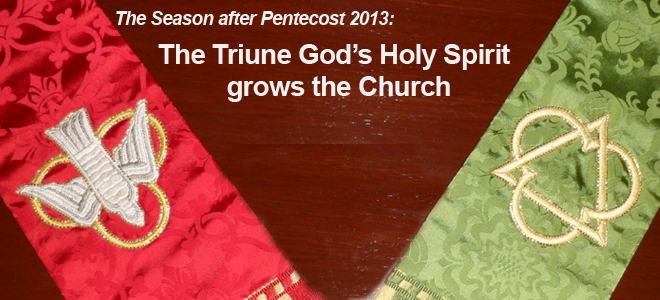 The Day of Pentecost is a sort of transition point between (1) the half of the Church Year that focuses on the life and ministry of the Lord Jesus Christ to save all people from their sins by grace through faith in Him and (2) the half of the Church Year that focuses more on His teaching and deeds as they grow the Church, the assembly of those who believe around His purely preached Word and rightly administered Sacraments. The Day of Pentecost in one sense belongs to the Easter Season, but it also can be said to begin the season that follows it, which season is generally colored green to bring to mind the life and growth evident in foliage and fruit.
The Day of Pentecost is a sort of transition point between (1) the half of the Church Year that focuses on the life and ministry of the Lord Jesus Christ to save all people from their sins by grace through faith in Him and (2) the half of the Church Year that focuses more on His teaching and deeds as they grow the Church, the assembly of those who believe around His purely preached Word and rightly administered Sacraments. The Day of Pentecost in one sense belongs to the Easter Season, but it also can be said to begin the season that follows it, which season is generally colored green to bring to mind the life and growth evident in foliage and fruit.
Fifty days after Jesus rose from the dead, He sent a special gift of the Holy Spirit to His chosen apostles as He had promised (see, for example, Acts 1-2). The gift appeared as fire that rested on them but showed itself by enabling the apostles to speak in the languages of the Jews gathered in Jerusalem for the Old Testament festival of Pentecost. Through the apostles’ preaching, the Holy Spirit added some 3,000 souls to the Church. Thus, the Old Testament harvest festival of Pentecost was fulfilled by the New Testament day that has the same name. Red is the usual color for The Day of Pentecost, bringing to mind the fire of the Holy Spirit and the blood of the martyrs who died bearing His message. (Pentecost was once known as “White Sunday” or “Whitsunday” for the white robes worn by the newly baptized.)
The First Sunday after Pentecost has long been observed as Trinity Sunday. The day celebrates less the teaching about the Holy Trinity and celebrates more the richness of the being of the Triune God, three Persons of one divine substance. The occasion can be a thankful review of the salvation Father, Son, and Holy Spirit accomplish for us. White is the usual color for Trinity Sunday, bringing to mind joy and glad celebrations, light and purity, and the innocence that is ours by Holy Baptism through which we receive Christ’s righteousness.
The Sundays of the rest of the season begun with The Day of Pentecost and Trinity Sunday—whether called Sundays after Pentecost (as with our current lectionary series), Sundays after Trinity (as with older lectionary series), or Sundays of Ordinary Time (as in other church bodies, which sometimes see Lent and Easter as interrupting the time begun after the Baptism of the Lord back in Epiphany)—generally span the rest of the Church Year, no matter its length. For those Sundays, the dates and Gospel Readings (according to Lutheran Service Book Series C) are listed below, and you may note that, in this particular Church Year, on three dates other observances may take precedence over the usual “green” Sunday.
• Second Sunday (06/02): Jesus heals a centurion’s servant (Luke 7:1-10)
• Third Sunday (06/09): Jesus raises the son of the widow of Nain (Luke 7:11-17)
• Fourth Sunday (06/16): Jesus is anointed by a sinful woman (Luke 7:36-8:3)
• Fifth Sunday (06/23): Jesus casts out demons into a herd of pigs (Luke 8:26-39)
• Sixth Sunday (06/30): Jesus sets His face to Jerusalem (Luke 9:51-62)
• Seventh Sunday (07/07): Jesus sends out seventy-two others (Luke 10:1-20)
• Eighth Sunday (07/14): Jesus teaches about a good Samaritan (Luke 10:25-37)
• Ninth Sunday (07/21): Jesus is welcomed by Mary and Martha (Luke 10:38-42)
• Tenth Sunday (07/28: Jesus teaches about prayer (Luke 11:1-13)
• Eleventh Sunday (08/04): Jesus tells the Parable of the Rich Fool (Luke 12:13-21)
• Twelfth Sunday (08/11): Jesus calls us to seek His kingdom (Luke 12:22-34)
• Thirteenth Sunday (08/18): Jesus comes not for peace but division (Luke 12:49-53)
• Fourteenth Sunday (08/25): Jesus says to strive to enter the narrow door (Luke 13:22-30)
• Fifteenth Sunday (09/01): Jesus heals and teaches about banqueting (Luke 14:1-14)
• Sixteenth Sunday (09/08): Jesus tells how we will bear our own crosses (Luke 14:25-35)
• Seventeenth Sunday (09/15): Jesus teaches two “lost” parables (Luke 15:1-10)
• Eighteenth Sunday (09/22): Jesus tells the Parable of the Dishonest Manager (Luke 16:1-15)
• St. Michael and All Angels (09/29): Satan falls from heaven but children’s angels see God (Luke 10:17-20; Matthew 18:1-11)
• Twentieth Sunday (10/06): Jesus teaches about temptation to sin and faith that forgives (Luke 17:1-10)
• Twenty-first Sunday (10/13): Jesus cleanses ten lepers (Luke 17:11-19)
• Twenty-second Sunday (10/20): Jesus tells the Parable of the Persistent Widow (Luke 18:1-8)
• Twenty-third Sunday (10/27): Jesus teaches how to worship and be justified (Luke 18:9-17)
• All Saints’ Day observed (11/03): Jesus describes the blessed saints (Matthew 5:1-12)
• Twenty- fifth Sunday (11/10): Jesus says God is God of the living (Luke 20:27-40)
• Twenty- sixth Sunday (11/17): Jesus gives signs of the end (Luke 21:5-36)
• Last Sunday of the Church Year (11/24): Jesus warns of the last days (Luke 23:27-43)
The last Sunday of the Church Year has also been variously observed as the Sunday of the Fulfillment or as Christ the King Sunday. Regardless of its title, the last Sunday looks forward to when all things in heaven and earth will be together under one head, Jesus Christ, and it thereby also itself transitions to the following season of Advent.
You may read and hear the sermons at Pilgrim from the Time of the Church and from the rest of the Church Year here.
The banner graphic at the top of this page shows Pastor Galler’s traditional red and green stoles with traditional symbols of the Holy Spirit and the Triune God, respectively.

